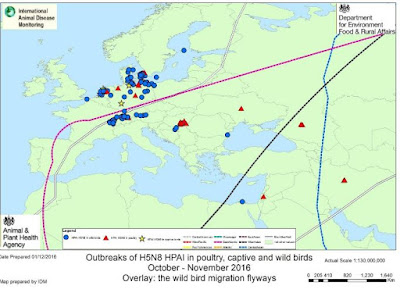#11,964
As the following 4th update from the UK's DEFRA (Department for Environment, Food & Rural Affairs) states, the spread of HPAI H5N8 throughout Europe and into the the Middle East is rapidly evolving, and so status maps - like the one above - are changing on a daily basis.
The following report offers an excellent overview of H5N8's progress, up to and including reports of its arrival in Egypt and the Ukraine, which was only just reported yesterday.
Department for Environment, Food and Rural Affairs
Animal & Plant Health Agency
Veterinary & Science Policy Advice Team - International Disease Monitoring
Updated Outbreak Assessment number 4
Highly Pathogenic Avian Influenza H5N8 in Europe
1st December 2016 Ref: VITT/1200 Avian Influenza in Europe
Disease Report
Since our last update on the 18th November, reports of H5N8 HPAI in wild birds, poultry and captive birds are continuing with several new EU countries now affected (Finland, France, Romania and Sweden). There have now been 35 outbreaks in domestic poultry (Austria, Hungary, Germany, Netherlands, Denmark and Sweden), five in captive birds (Germany and Netherlands), one in captive wild birds (France) and over 150 reports in wild bird die-offs (see map).
The viruses associated with these events share high genetic similarity but may have been introduced via different migratory pathways/species. The UK has not reported any cases or outbreaks. The migration routes shown are only figurative and are used to indicate that there could be two migration routes involved in the spread of disease into Europe.
Outbreaks have been reported in Southern Russia, Iran and Israel in the last month and recently in Egypt and the Ukraine which adds credence to the involvement of the Black Sea / Mediterranean and the East Atlantic migration routes.
The wild bird species in which disease has been confirmed include Tufted Ducks (Aythya fuligula), Common Pochards (Aythya feriena), mute swans (Cygnus olor) and various gulls (Larus sp.) as well as other waterfowl, such as grebes, curlews, herons and coots and some raptor species. Some of these species may be affected since they will scavenge and feed on dead waterfowl. However there may be other wild birds involved which are not showing such severe clinical signs.
The situation is evolving fast, and these numbers represent the official reports made to the OIE or the EU ADNS system to date. For up-to-date information on the situation in the EU, also see the Commission website at https://ec.europa.eu/food/animals/animal-diseases/control-measures/avian-influenza_en
Situation Assessment
Of the domestic poultry outbreaks, several have been reported in commercial flocks. In Austria, a single free range turkey flock tested positive in early November, but no further outbreaks since then. In Germany, two large commercial flocks, one of parent breeder layers and one in turkeys were reported. In Hungary, young ducks have been affected with varying levels of mortality and neurological disease, as well as geese and turkeys, and there has been secondary spread within the duck sector. In the Netherlands, a large duck premises has tested positive, but further testing within the 10km zone and of linked premises showed no further spread. In Sweden a large layer premises has tested positive.
n all cases, disease control measures were put in place in accordance with the EU Legislation. In France (Pas de Calais region and the closest case to the UK), captive decoy ducks tested positive. These birds are considered wild birds as they are sedentary and not associated with any commercial poultry.
As a result of the increase in cases in wild birds in Europe, we ask that the public use the Defra helpline (Tel: 03459 33 55 77) to report any wild bird die-offs. In particular, where more than five birds of any species are found dead but also where a single wild duck, wild goose, swan or gull is found. Not all birds may be picked up for testing but we will monitor where the cases are found to triage the testing so it is important that we gather this information.
In particular, we urge poultry keepers to monitor their sites for any wild birds found dead and notify the Defra helpline. Information is available here: https://www.gov.uk/guidance/avian-influenza-bird-flu including updated biosecurity advice for poultry keepers which they should take note of: https://www.gov.uk/government/uploads/system/uploads/attachment_data/file/573077/captive-birds-biosecurity-preventing-disease-161129.pdf
Conclusion
This risk to the UK remains at MEDIUM for any incursion of H5N8 HPAI as a result of wild bird movements and LOW, YET HEIGHTENED for exposure to domestic poultry. The migration season is expected to have peaked between December and January when migratory birds will be present at wintering sites in the UK, but these birds are already arriving and have been for several weeks.
The risk to poultry depends upon the level of biosecurity implemented on farm to prevent the direct or indirect contact with wild birds or their infective faeces. It should be noted that the virus could potentially survive on pasture in wild bird faeces for several weeks at current ambient temperatures emphasising the importance of these measures.
Poultry keepers and veterinarians should remind themselves of the clinical signs caused by avian influenza viruses (see Irvine, 2013, for more details).
We would like to remind all poultry keepers to maintain high standards of biosecurity, remain vigilant and report any suspect clinical signs promptly. Whilst clinical signs in not just chickens and turkeys, but also geese and ducks with this strain of H5N8 HPAI can be very marked with often rapid onset, they may initially manifest as reductions in feed or water intake (>5%). Furthermore clinical signs in domestic waterfowl for this current strain of virus may present as a wide spectrum with variable mortality.
